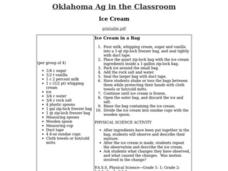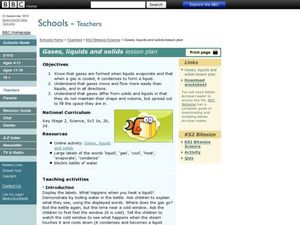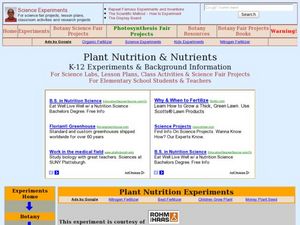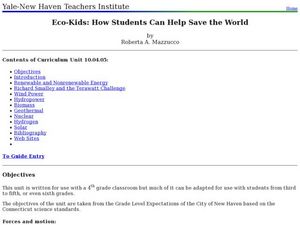K-State Research and Extensions
The Crusty Earth
Geology rocks — literally! A geology chapter offers eleven activities at four different levels. Scholars enjoy completing hands-on experiments before applying critical thinking skills following a share, process, generalize, apply, and...
Curated OER
Dissolving Salt
Fifth graders, in groups, complete an experiment/activity in which they dissolve salt in a cup of hot water and then observe what happens as the water evaporates over the next few weeks.
Curated OER
Diaper Inquiry
Fifth graders carefully examine and investigate the products contained in a diaper. They particularly analyze the crystal sodium polyacrylate, a product developed for use in astronaut diapers. They follow the scientific method, forming...
Curated OER
Vapor Pressure
In this vapor pressure worksheet, learners use a given graph of the vapor pressure of four liquids to answer eleven questions. They compare and find boiling points and vapor pressures of propanone, ethanol, water, and ethanoic acid.
Curated OER
Hot Cans and Cold Cans
Learners investigate the physics of heating and cooling through conduction, convection, and radiation. Working in groups, they determine the best way to cool a can of water and warm a can of water. Temperature is taken at five minute...
Curated OER
Making Cents of Density
Middle schoolers utilize their knowledge of the physical properties of matter such as mass, volume, and density to solve a problem. They utilize the scientific method to solve a problem. Pupils analyze their data to determine whether...
Curated OER
Happy Birthday, Martin Luther King
Students complete a variety of activities related to the book "Happy Birthday, Martin Luther King." They identify Martin Luther King's goals, discuss and write about things they hope will happen in the world for a class book, explore...
Curated OER
The Intertidal Zone: Tide and How Creatures Survive
Students explore oceanography by completing science worksheets. In this tide pools instructional activity, students discuss the forces of the tide pools, the animals that live within them, and the impact they have on the rest of the...
Curated OER
The Solar System
Third graders investigate Newton's law of Motion. In this chemical reaction lesson, 3rd graders participate in an experiment with rockets to study Newton's law. Students observe the effects of a chemical reaction made by combining...
Curated OER
Let's Make a Compost Cake
Students create a compost cake. For this gardening and decomposition science lesson, students review and describe the "nutrient cycle." Students create a compost pile, measure and record the dimensions and temperature of the pile, and...
Curated OER
Ice Cream
Students create ice cream in a bag and snow ice cream to study the effects of freezing on foods. In this ice cream lesson, students understand the effects of freezing on cells.
Curated OER
Applied Science -Physics (2B) Pre Lab
Second graders look at different types of energy. In this energy lesson, 2nd graders define energy and the difference between kinetic and potential energy. They see examples with falling books and a slinky.
Curated OER
Gases, Liquids and Solids, evaporate, shape volume,
Students conduct an online experiment to discover what happens to solids, liquids and gases in different temperatures. In this states of matter lesson, students get into pairs and work in a virtual laboratory to manipulate heating and...
Curated OER
Plant Nutrition and Nutrients
Students observe seeds growth and examine the different parts of the seedling. In this biology lesson, students compare the growth of seeds planted in soil and in hydroponics. They record their observations in their science journal and...
Curated OER
Hot n' Cold
Students keep a weather log. For this weather and temperature lesson, students discuss the information that can be obtained from a map and lead into a discussion about temperature. Students watch a video about temperature and...
Curated OER
Native Planting for the Built or Green Environment
Students identify the terms used in naturescaping. They identify how to plant, how to do site preparation and how to develop a plan. Students explore the benefits of naturescaping for the health of the environment. They also...
Curated OER
The Atom
In this atom worksheet, students read about the parts of the atom and how atoms combine into molecules and compounds. Students learn how to read a periodic table. This worksheet has 20 fill in the blank and 10 matching questions.
Curated OER
Rocks and Rock Formation
In this rock formation worksheet, students read a 2 page detailed text about rocks and their formation. Students then answer 15 essay, matching and multiple choice questions about the information.
Curated OER
Integrating Chemistry-Chemical Reactions
In this chemical reactions worksheet, students read about different types of chemical reactions, potential and chemical energy. They answer three questions about their reading.
Curated OER
The Atom
In this atom worksheet, students read about the structure of the atom including its subatomic particles and John Dalton's theory of the atom. Students also read about the differences between atoms, molecules and compounds. They answer 30...
Curated OER
Air Is there
Learners experiment to observe air and its mass. In this air lesson, students use the scientific method to complete experiments that demonstrate the properties of air. Learners view a video as follow-up.
Curated OER
Sharks: Fact or Fiction
Second graders discover the truth about sharks. In this shark lesson, 2nd graders use different resources to help distinguish between fact and fiction with what they have heard about sharks. They complete an attached activity sheet.
Curated OER
Rainforest Food Chain
Students investigate a rainforest food chain. In this ecology lesson, students are shown pictures of plants and list what animals might eat the plants. Students continue to think of what other animals might eat those animals. Students...
Curated OER
Eco-Kids: How Students Can Help Save the World
Fourth graders identify the different types of renewable and nonrenewable energy sources. In this ecology instructional activity, 4th graders create models of wind mills and hydropower. They discuss the pros and cons of using alternative...

























